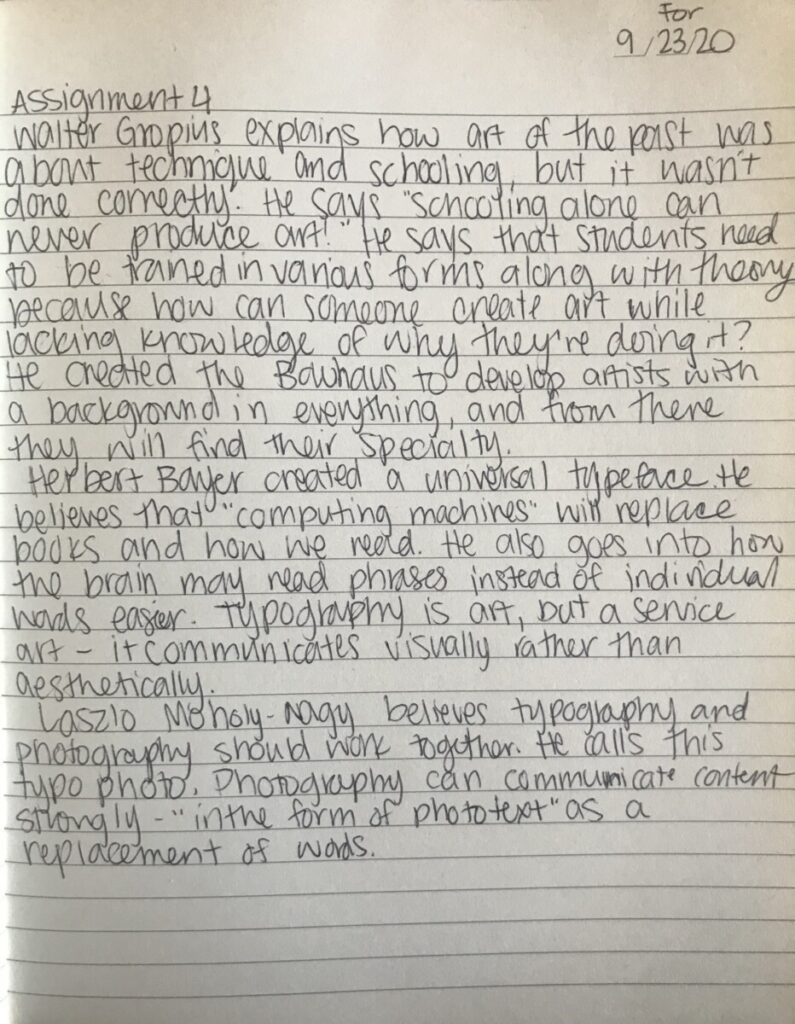One thing lacking in art of the past wasn’t in the art itself, but in the way the academy (education) approached art. It is mentioned by author Walter Gropius that the way in which the academy taught art, resulted in something called “Isolation of the Artist”. He states that “The fundamental pedagogic mistake of the academy arose from its preoccupation with the idea of the individual genius and its discounting the value of commendable achievement on a less exalted scale” (Gropius 310). This led to a high number of unsuccessful artists, useless by product of their schooling. With this Gropius suggests that what lacked in the art of the past was a different approach to how it was taught.
Looking for hope in the future art, authors Herbert Bayer, present ideas to improve it, like the idea of Universal Communication. He believes that the amount of different languages we have have led to barriers of communication and as a solution to this problem, suggests “a more universal visual medium to bridge a gap between them” (Bayer 47). Artists have taken their part in beginning to evolve such communication gaps, and now, he wants scientists to do the same. Bayer believes the main support systems for this idea could be pictorial communication, which is already an older concept, and should now be adapted into text-picture integration.
Another idea he suggests is square spanning. Traditionally, we read texts horizontally, but how about we begin to adapt to vertical reading? “There is no reason for this to be the only method to transmit language to the eye. sentences could as well follow each other vertically or otherwise, if it would facilitate reading” (Bayer 47). Grouping words into short lines horizontally can ease understanding and help. Both of the above ideas help form complementary images and will also have to bring about a change to the colors used on prints to better associate images and vertical text groups to their meanings, helping understand.
Author László Moholy-naGy believes that “The creative work of the artist, the scientist’s experiments, the calculations of the businessman or the present-day politician..” ( Moholy-naGy 33) is what binds together the roles typography, photography, and other media play in the new art. Using for example the long term effect of the printer; something one man invented that is now used in various forms, such as photography, stereotype, electrotype, phototype, etc. “Only quite recently has there been typographic work that uses the contrasts of typographic material (letters, signs, positive and negative values of the plane) in an attempt to establish a correspondence with modern life” (Moholy-naGy 34). However, it hasn’t had much effect, and so Moholy-naGy believes that also embracing different techniques in other areas of typography, photography, and other media can be more effective to new art. He admits that in this new type of work, things will have to be different from the linear typography that is used today, but is confident that they can be well worth it and effective in new art. He goes on to give ideas for future uses like printing presses having their own block-making plant and printing with X-ray radiography.
According to Walter Gropius, the artist of the past created art based on experience, working their way up from the bottom, living as part of the community, and participating in life. However, artists now are taught that art is a profession that can be mastered by studying it. He feels quality and talent cannot be taught, however, manual dexterity can. “…manual dexterity and the thorough knowledge which is a necessary foundation for all creative effort, whether the workman’s or the artist’s, can be taught and learned” ( Gropius 310). The skill of performing artistic tasks manually is something Gropius feels the academy can teach artists. He also believes that they can teach artists to connect their art to the community with things like their use of materials so that they don’t end up with a great idea like the art-proletariat movement that ends up in the ruin because of lack of connection to the community.
An idea that needs to be updated is the way in which art is taught in schools and academies; taking for example the Bauhaus at Weimar. The Bauhaus was a school in Germany that decided to take a different approach to teach the art in order to produce more successful artists and give them a more expansive understanding of it. Its statement of belief was, “‘ The Bauhaus strives to coordinate all creative effort, to achieve, in a new architecture, the unification of all training in art and design. The ultimate, if the distant, goal of the Bauhaus is the collective work of art– the Building in which no barriers exist between the structural and decorative art’” ( Gropius 311). This is an idea that needs to be updated and applied to all art academies. Another idea I believe should be updated and used in the 21st century was the idea of Universal Communication, presented by Walter Gropius advocating for a bridge in the communication barrier through the arts.




Recent Comments